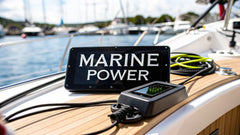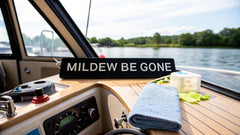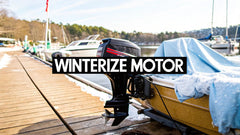boat anchor systems: Ultimate Guide to Secure Mooring
A good boat anchor system is way more than just a hunk of metal you toss overboard. It’s arguably the single most critical piece of safety equipment on your vessel. We call the whole setup 'ground tackle,' and it's your emergency brake out on the water, designed to hold you fast whether you're in a calm cove or caught in a nasty squall.
For your anchor to do its job, every single component has to work together perfectly.
Your Boat's Most Critical Safety Gear
Think about the brakes on your car. It’s not just one part doing all the work. You’ve got pads, rotors, calipers, and fluid all working in sync to bring you to a safe stop. Your boat’s anchor system is built on that same idea of teamwork. Just having a big, heavy anchor is like having great brake pads but a leaky brake line—the system is going to fail right when you need it most.
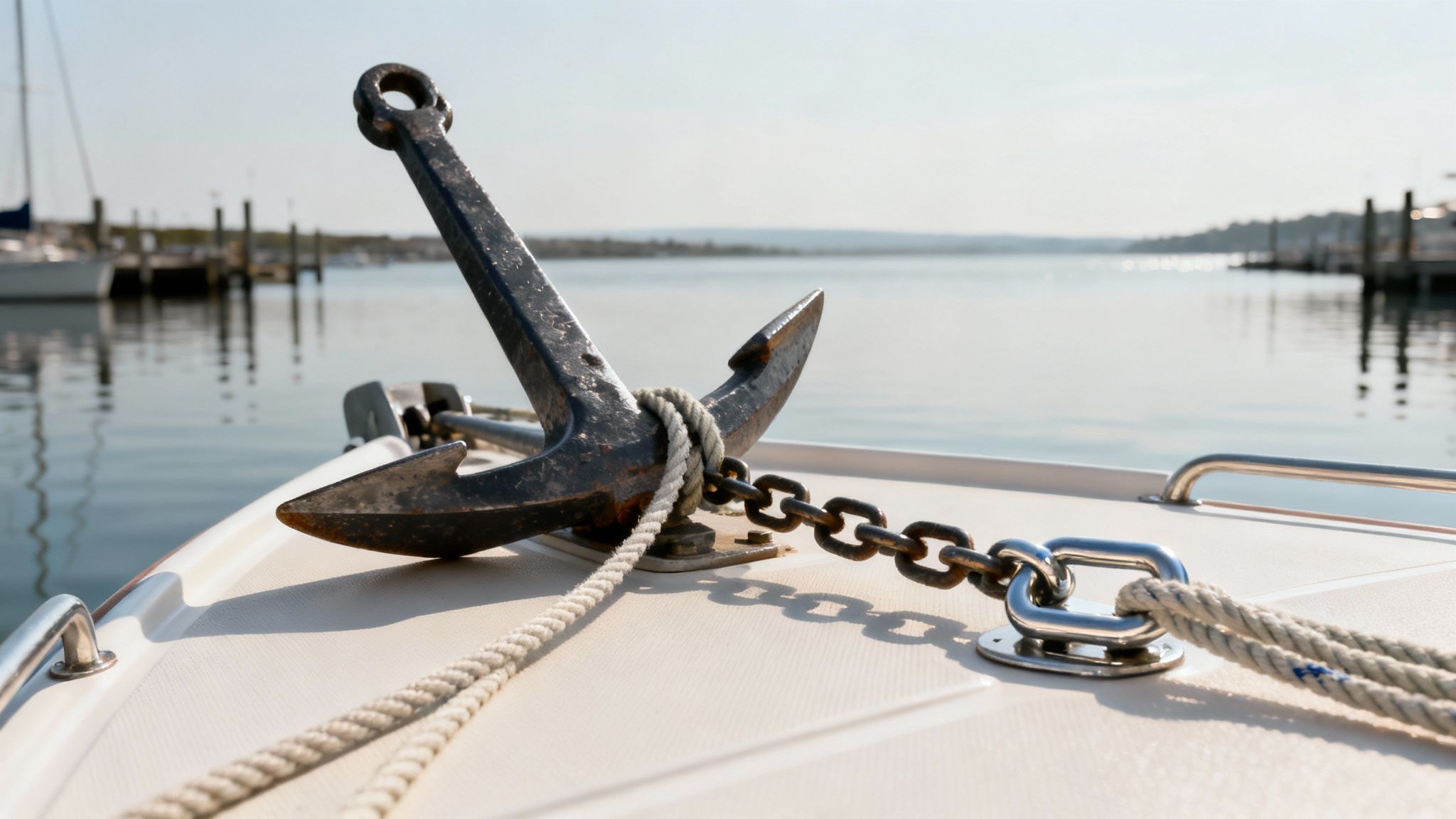
This whole interconnected system is what creates real holding power. It’s a dynamic relationship where every piece has a vital role to play. Without a solid, complete setup, you’re just one gust of wind away from drifting into another boat, onto the rocks, or into dangerously shallow water.
The Core Components of Ground Tackle
Getting a handle on the key parts of a boat anchor system is the first step to anchoring safely and effectively. The whole rig is only as strong as its weakest link, so knowing what each component does is essential for every boater.
The main parts you'll be working with are:
- The Anchor: This is the tool that actually digs into the seabed to get a grip.
- The Rode: This is just the nautical term for the line, chain, or combination of both that connects your anchor to the boat.
- Connectors: These are all the little bits of hardware—shackles, swivels, and clips—that securely link the anchor to the rode and the rode to your boat.
One of the biggest mistakes new boaters make is obsessing over anchor weight. The real magic of an effective anchor system comes from the angle of pull. A proper rode allows the anchor to dig in horizontally, burying itself for maximum grip, instead of being yanked straight up and out of the bottom.
More Than Just a Convenience
Sure, an anchor is great for stopping to fish or take a swim, but its number one job is keeping you safe. A reliable system gives you the confidence to know you can hold your position no matter what the weather decides to do. It lets you ride out a storm, deal with engine trouble without drifting, or simply enjoy a quiet night on the hook without a worry in the world.
This is why picking the right gear is a non-negotiable part of boat ownership. Beyond just the anchor, you need a complete approach to safety on the water; this ultimate boat safety equipment checklist is a great resource to make sure you're covered. Investing in a quality boat anchor system isn't about convenience—it's about protecting your boat, your crew, and yourself.
Taking a Look at Your Ground Tackle
The term "ground tackle" might sound like fancy boating jargon, but it's really just the name for all the gear that connects your boat to the bottom of the sea. Getting to know each piece of this system is the secret to building an anchor setup you can truly rely on. Think of it like a team—you need every player working together to win the game and keep you safely in place.
Let's break down the three essential components: the anchor itself, the rode that tethers it to your boat, and the hardware that ties it all together. Each part has a critical job, and if one fails, the whole system can be compromised.
The Anchor: Your Star Player
The anchor is the most obvious part of your ground tackle and the first thing most people picture. Its main job isn't to hold your boat by sheer weight but to dig into the seabed and create a powerful grip. A well-designed anchor uses the seafloor's own resistance to lock itself in place.
Different anchors are built for different types of seabeds. For most recreational boats, they fall into two main camps:
- Plow-Style Anchors: Shaped just like a farmer's plow, these are fantastic all-rounders that perform well in sand, mud, and clay. Their smart design actually makes them dig deeper the more force is put on them.
- Fluke-Style Anchors: Often called Danforth anchors, these have two sharp flukes that are superstars in soft mud and sand. They deliver incredible holding power for their relatively light weight.
Choosing the right anchor is a big topic all on its own. For a much deeper dive, check out our guide on anchor styles, weights, and materials to find the perfect fit for your vessel.
The Rode: The Unsung Hero
The rode is simply the line or chain connecting your anchor to the boat. It does a lot more than just create a link, though. It’s absolutely essential for setting the anchor correctly and absorbing the shock from wind and waves. The type of rode you use has a massive impact on how your entire anchor system performs.
You’ll find three main types of rodes, each with its own pros and cons:
-
All-Chain Rode: This is the heavyweight champion of rodes. It's incredibly tough and abrasion-resistant, which makes it perfect for cruising in rough weather or anchoring over rocky bottoms. Its own weight is a huge advantage, as it helps keep the pulling angle on the anchor low, allowing it to dig in deep and stay put. Our galvanized anchor chains are built to handle exactly these kinds of harsh marine environments.
-
Nylon Rope Rode: A rode made completely of nylon rope is lightweight and much easier to handle. Its biggest benefit is its natural elasticity—nylon can stretch up to 40% of its length. This acts as a fantastic shock absorber, reducing the jarring stress on your boat and anchoring hardware when things get choppy.
-
Combination Rode: This hybrid setup gives you the best of both worlds. It usually pairs a short length of chain (15-30 feet) attached directly to the anchor with a much longer section of nylon rope. The chain provides the weight needed to keep the anchor shank low for a good set, while the nylon rope adds that crucial shock absorption and keeps the overall weight manageable. Our durable nylon anchor lines are a great choice for this kind of system.
The growing popularity of boating has fueled a strong demand for these components. The global boat anchor chain market, for example, is estimated to be worth around $500 million, with a projected growth rate of nearly 5% annually through 2033. This just goes to show how much the industry relies on high-quality gear. You can discover more insights about the boat anchor chain market on archivemarketresearch.com.
The Connectors: The Critical Links
Finally, you have the small pieces of hardware that join everything together. These bits and pieces, like shackles and swivels, might seem minor, but they are absolutely critical to the integrity of your anchor system. Skimping on these with underrated or corroded hardware is one of the most common points of failure.
Think of your connecting hardware like the bolts holding an engine together. They may be small, but without them, the entire machine falls apart under pressure. Always invest in high-quality, marine-grade stainless steel connectors.
Here’s a quick look at the key players:
- Shackles: These are the U-shaped metal fittings that connect your anchor to the chain, and the chain to the rope. It is vital to use a properly rated shackle that is at least as strong as the chain or line it's connecting.
- Swivels: A swivel is installed between the anchor and the rode to stop the line from twisting up as your boat swings with the wind and current. This helps the anchor set properly and makes hauling it back up a lot easier.
Together, the anchor, rode, and connectors form a complete system. When you choose each part carefully and keep it well-maintained, you get the security and peace of mind every boater deserves.
How to Choose the Right Anchor for Your Boat
Picking the right anchor isn't about finding some mythical "best" one that works everywhere. It's about finding the perfect match for your boat, the specific seabeds you drop it on, and how you actually use your vessel.
Think of it like choosing tires for a truck. You wouldn't put slick racing tires on a 4x4 you plan to take through the mud. It's the same logic with your boat's anchor system—the right gear for the job is what keeps you safe and sound.
Matching Anchor Design to the Seabed
The real secret to an anchor's holding power is simple: how well it can dig in and grip the bottom. Different designs are absolute specialists at this, each engineered for a particular type of seafloor. A massive, heavy anchor that just skids across the bottom is completely useless, while a lighter one that sets perfectly can hold a boat many times its weight.
Here are the most common designs you'll run into:
- Plow-Style Anchor: Just like its name suggests, this anchor looks and acts like a farmer's plow. It's a fantastic all-rounder that's built to dig deep into soft bottoms like mud, sand, and clay. Its biggest advantage is its ability to reset itself if a shift in wind or current pulls it free.
- Fluke-Style (Danforth) Anchor: This classic design uses two big, sharp flukes to get an incredible grip in soft sand and mud. Pound for pound, a Danforth anchor offers some of the best holding power out there, making it a super popular choice for both main and backup anchors.
- Claw-Style (Bruce) Anchor: The claw is a boater's favorite because it sets so quickly and reliably across a whole range of seabeds, from sand and mud to even rocky bottoms. It might not have the same holding power-to-weight ratio as a fluke in soft stuff, but its versatility is hard to beat.
- Modern Scoop Anchors: Newer designs have really upped the game. Many feature a roll bar and a weighted tip that force the anchor to orient itself correctly and dig in almost instantly. They're known for their phenomenal holding power across most bottom types, though they often come with a higher price tag.
To really zero in on the perfect anchor, you need to weigh your boat's size and displacement against the type of anchoring you'll be doing. We offer a full range of high-performance anchors to ensure you have the right tool for the job.
Anchor Type Performance by Seabed
To help you sort through the options, I've put together a quick-reference table. It breaks down how each of these common anchor types stacks up against different bottom conditions. Think of it as a cheat sheet for matching the right tool to the job.
| Anchor Type | Best For (Seabed) | Good For | Poor For | Key Advantage |
|---|---|---|---|---|
| Plow-Style | Sand, Mud, Clay | Gravel | Heavy Grass, Hard Rock | Excellent at resetting itself |
| Fluke-Style | Soft Mud, Sand | Light Gravel | Rock, Coral, Heavy Grass | Highest holding power-to-weight ratio |
| Claw-Style | Sand, Rock, Mud | Clay | Thick Seaweed, Very Soft Mud | Sets quickly and reliably |
| Scoop-Style | Most Seabeds | Varied Conditions | Extremely Hard or Foul Ground (snag risk) | Sets fast with very high hold |
Once you've got your anchor type figured out, the decision-making isn't quite over. You also have to think about the rest of your ground tackle—namely, whether an all-chain or rope-and-chain rode is right for your setup.
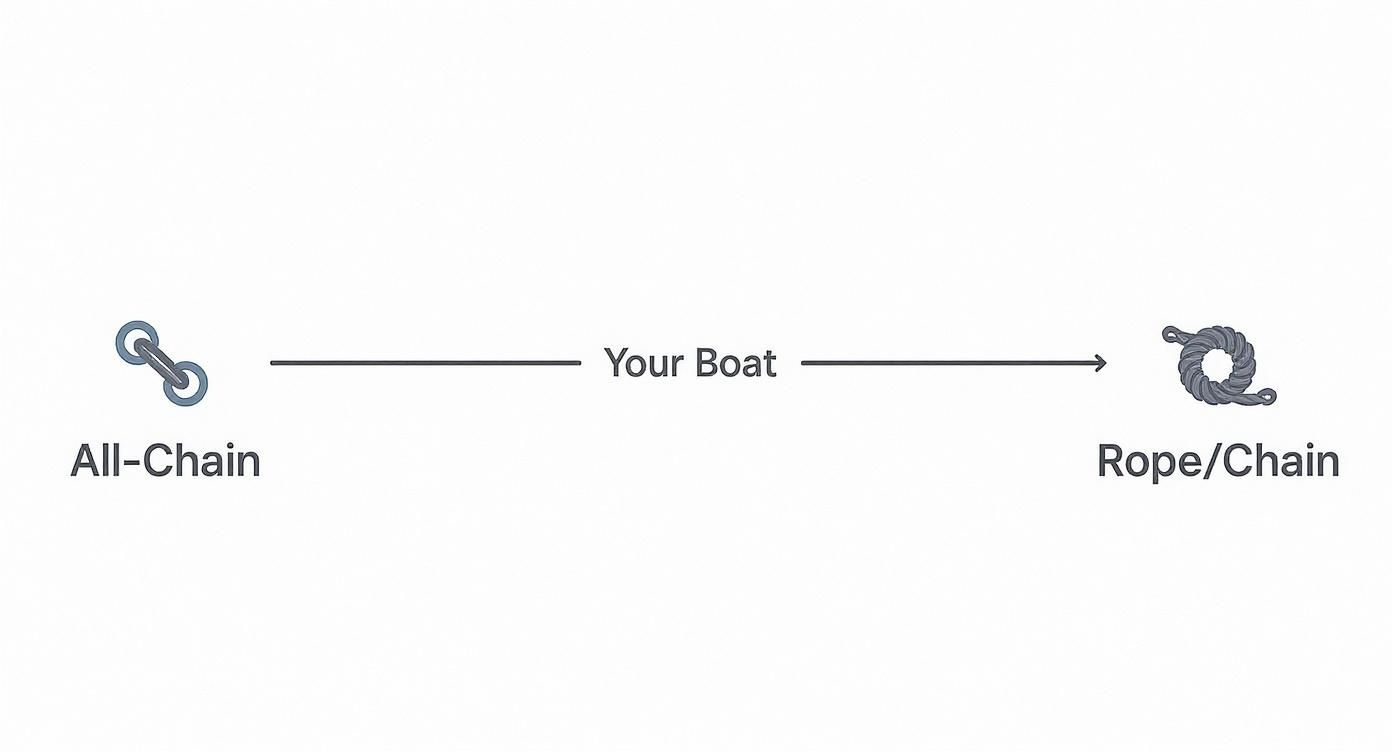
This decision comes down to balancing the durability and sheer weight of an all-chain system against the shock absorption and lighter load of a hybrid rope-chain rode.
The Growing Market for Reliable Anchors
We're not the only ones who know how critical good anchoring gear is. The global boat anchor market is a serious business, valued at around $2 billion in 2023 and expected to climb to nearly $2.6 billion by 2028.
What's driving this? More people are getting out on the water, and constant innovation is making anchors that are both more effective and easier to handle.
Investing in the right anchor isn't just an expense; it's an investment in your safety and peace of mind. A slightly oversized, high-quality anchor that's properly matched to your boat will pay for itself the first time you ride out an unexpected squall without dragging an inch.
Mastering the Art of Anchor Scope
If you've ever watched a seasoned boater drop anchor with zero fuss, you've seen the magic of one critical concept: scope. It's one of the most important—yet most overlooked—secrets to making sure your anchor holds fast. Simply put, scope is just the ratio of anchor line you let out compared to the depth of the water.
Nailing this ratio is the difference between an anchor that bites into the seabed like a pitbull and one that just skips along the bottom, doing absolutely nothing. Think of it like flying a kite. A short string in a strong wind just yanks the kite awkwardly into the air before it stalls. A nice long string, however, lets it soar at a low, steady angle. Your anchor works the same way; more line creates a lower, more horizontal angle of pull, which is exactly what an anchor needs to dig in and get a grip.
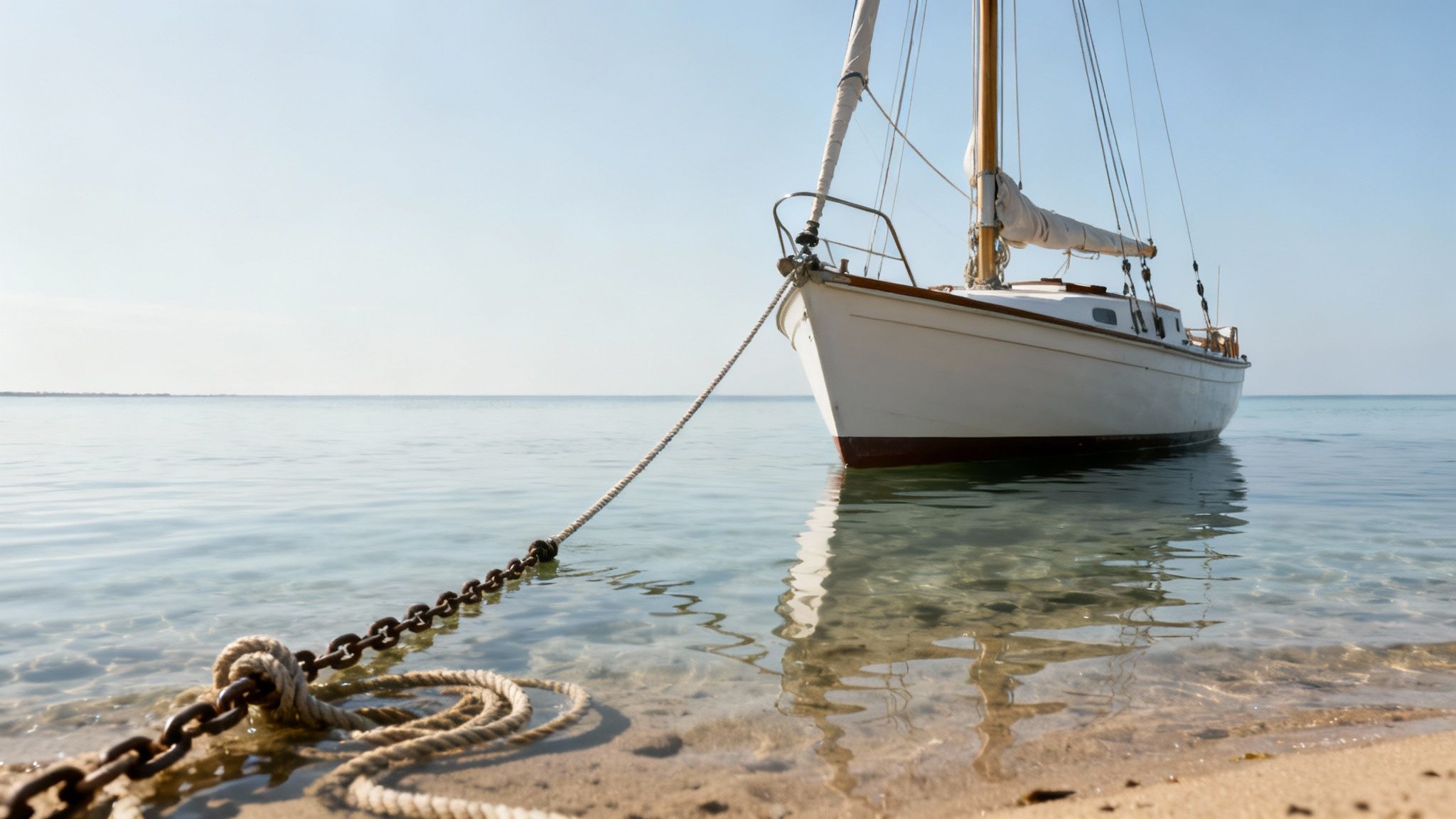
Without enough scope, any tug from the wind or current will lift the anchor's shank, causing it to break free and start dragging. This is why just having a heavy anchor isn't the whole story. The real key is using the right geometry to unlock its holding power.
Calculating the Perfect Scope
Figuring out the right scope isn't rocket science, but it's more than just glancing at your depth finder. You have to account for the total vertical distance from your anchor to your boat. That means the water depth plus the height from the water's surface up to your bow roller or cleat.
Here's the simple formula to remember:
(Water Depth + Bow Height) x Desired Ratio = Total Rode Length
So, if you're in 20 feet of water and your bow sits 5 feet above the waterline, your magic number for the calculation is 25 feet.
Let's plug that into a few real-world situations:
- Calm Conditions (5:1 Scope): 25 feet x 5 = 125 feet of rode. This is your go-to for a quick lunch stop on a glassy, windless day.
- Moderate Conditions (7:1 Scope): 25 feet x 7 = 175 feet of rode. This is the gold standard for most overnight anchoring situations. It's reliable and safe.
- Heavy Weather (10:1 Scope or more): 25 feet x 10 = 250 feet of rode. When the wind starts howling and the waves are kicking up, paying out more line is cheap insurance against dragging anchor.
One of the most common mistakes is forgetting to add the boat's freeboard (the bow height) to the water depth. Those few feet might not seem like much, but they dramatically change the pulling angle on your anchor, weakening its hold right when you need it most. Always factor it in.
Why More Is Often Better
When it comes to scope, it’s almost always better to err on the side of caution and let out more line than you think you need. A longer rode, especially a nylon one, acts like a giant shock absorber. It cushions the sudden, jarring forces from wind gusts and waves, reducing the peak strain on your anchor and deck hardware.
Having plenty of high-quality line is a must for this technique. Our pre-spliced anchor lines are available in different lengths to make sure you've always got enough rode on hand to set a safe scope.
Of course, if you're using a combination of chain and rope, figuring out the right balance is another key piece of the puzzle. To really dial in your setup, check out our guide on how much anchor chain you need.
Once you truly understand scope, anchoring stops being a stressful guessing game and becomes a reliable, repeatable skill. It's the key to kicking back and enjoying your time on the hook with total peace of mind.
Upgrading Your System with Modern Technology
While traditional boat anchor systems have a beautiful simplicity to them, modern technology offers some incredible upgrades that make anchoring easier, safer, and a whole lot more precise.
These aren't just fancy gadgets for mega-yachts. They're practical, problem-solving tools that can save your back and give you a huge confidence boost when it's time to set the hook. Investing in the right tech can completely transform anchoring from a chore into a seamless part of your day on the water.
The single biggest upgrade for almost any boater is an anchor windlass. Think of it as a specialized winch mounted on your bow that does all the heavy lifting. With the push of a button or the turn of a handle, it deploys and retrieves your anchor, taking the back-breaking work out of the equation—especially in deep water or choppy seas.
The Power of a Windlass
When you're looking at a windlass, the main choice boils down to manual versus electric. A manual windlass is a big step up from pulling by hand, but an electric model is really the gold standard for convenience.
- Electric Windlass: Just press a button, and the anchor goes down or comes up. That speed and ease are priceless when you need to quickly reset your anchor or get underway without a hassle.
- Manual Windlass: These are easier on the wallet and don't require any electrical work. They use a crank to give you leverage, which is still worlds better than hauling hand-over-hand, though it does take some elbow grease.
A windlass isn't just a luxury; it's a game-changer for safety and accessibility. It allows boaters of any age or physical ability to manage their ground tackle confidently, encouraging more frequent and proper anchoring.
Smart Accessories for a Smarter System
Beyond the windlass itself, a few smaller accessories can make a huge difference in how your boat anchor system performs day-to-day. These little components solve common frustrations and add a welcome layer of precision.
An anchor swivel is a small but mighty connector that goes between the anchor and the chain. It lets the anchor rotate on its own, which stops your rode from getting all twisted up as the boat swings with the wind and current. This is key to making sure the anchor sets properly every time and comes up without a fight.
Another fantastic upgrade is a chain counter. This digital gadget tells you exactly how much rode you've let out, completely removing the guesswork from calculating your scope. While we don't carry these electronics, investing in quality gear for every part of your system is crucial.
A lot of the principles behind these upgrades actually trickle down from the commercial shipping world. The ship anchor market, which was valued at around $1.5 billion in 2023, is constantly pushing for innovation in holding power and material strength. That growth is tied directly to global trade and the need for rock-solid systems on massive vessels. Many of those engineering breakthroughs eventually get adapted for people like us, making our gear stronger and more reliable than ever. By embracing this technology, you can make your time at anchor safer and far more enjoyable.
Essential Maintenance for Your Anchor System
Your ground tackle is only as strong as its weakest link. Think about that for a second. Just like any other piece of critical safety gear on your boat, your anchor system demands regular attention.
This isn't just another chore to add to the list; preventative maintenance is the one thing that guarantees your anchor will work flawlessly when you absolutely need it most. If you let it go, you're inviting rust, chafe, and catastrophic failure right when you're counting on it to hold.
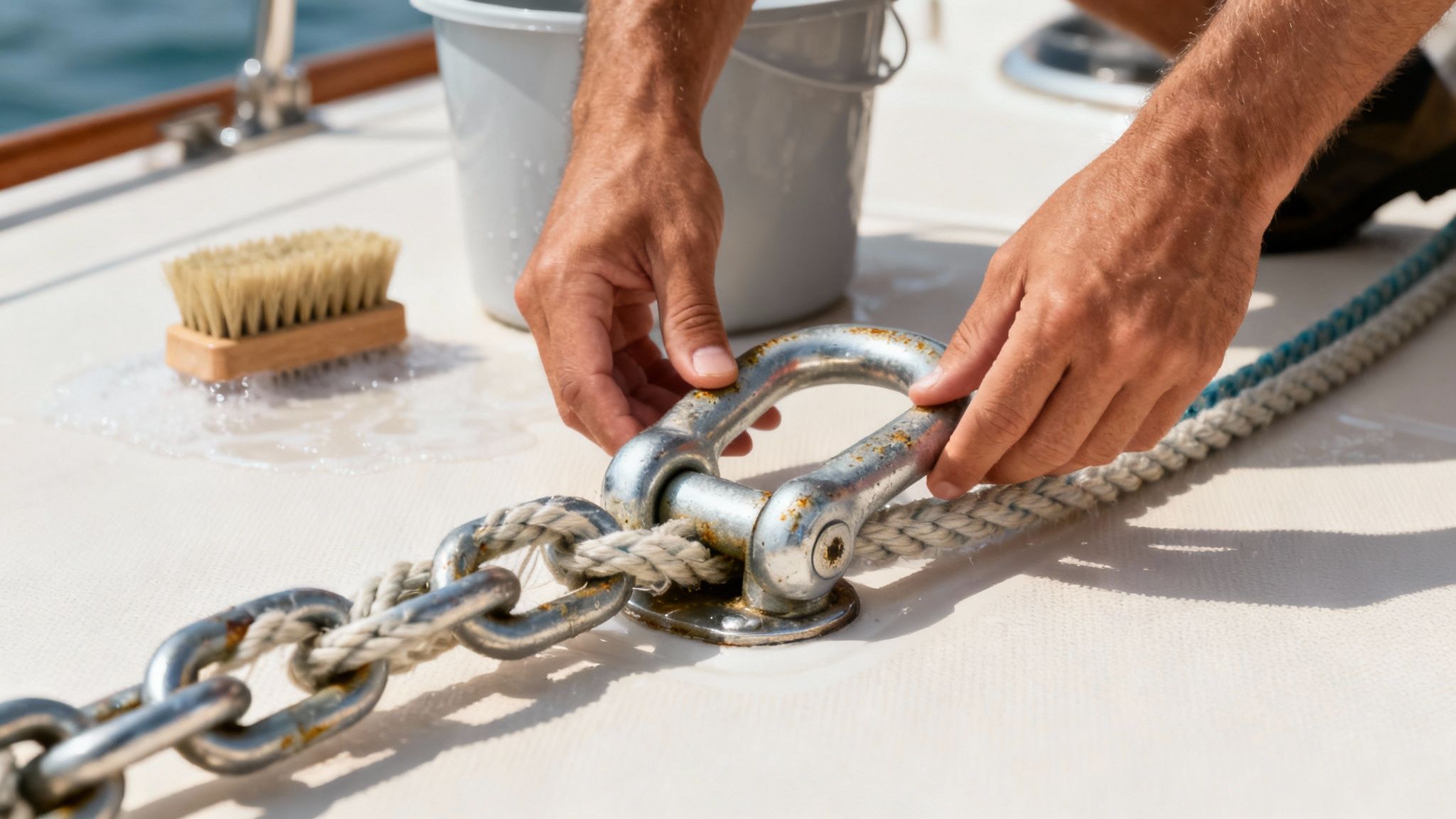
A simple once-over before you leave the dock and after you return can catch small problems before they spiral into big ones. Treat it like a quick health checkup for your boat's most important safety net.
Your Routine Inspection Checklist
Getting into a maintenance routine is easy. You’re really just looking for the obvious signs of wear, corrosion, and damage in a few key places. A few minutes spent inspecting your gear at the dock is a heck of a lot better than discovering a problem in the middle of a squall.
Here’s a practical checklist to get you started:
- Nylon Rodes: Run your hands along the entire length and look for signs of chafe. It’ll look like fuzzy, frayed sections. Also, feel for any spots that are stiff or discolored—that's a tell-tale sign of UV degradation weakening the rope fibers from the inside out.
- Anchor Chain: Keep an eye out for any rust or corrosion. This is especially important on galvanized chains where the protective coating can get worn away. Pay close attention to the links themselves to make sure none are bent, stretched, or worn dangerously thin.
- Shackles and Swivels: These critical connectors are notorious for seizing up with salt and corrosion. Make it a point to regularly unscrew them, clean the threads, and put a little waterproof grease on them. This ensures they operate smoothly and don’t become permanently frozen shut.
A seized shackle is impossible to open without a cutting tool, which could render your entire anchor system useless in an emergency. A yearly disassembly and lubrication of all connectors is one of the most important maintenance tasks you can perform.
Keeping Your Gear and Boat Clean
After every single trip, give your anchor and rode a good rinse with fresh water. It’s such a simple step, but it's incredibly effective at washing away the salt, mud, and tiny marine critters that speed up corrosion and can make your anchor locker absolutely reek.
A clean anchor locker is a healthy one. Giving it a deep clean every so often prevents that caked-on mud and grime from building up, which can clog your drains and create a damp, nasty environment perfect for mildew.
Using a quality boat cleaning supply kit makes it easy to stay on top of your deck hardware and anchor locker, protecting your investment from the harsh marine world. A little bit of regular care ensures every single part of your boat anchor system is ready for action whenever you are.
Got Questions About Anchoring? We've Got Answers.
Even after you get the hang of your anchor system, a few questions always seem to pop up. Let's tackle some of the most common ones I hear from fellow boaters, so you can drop your hook with a little more confidence.
How Do I Know What Size Anchor to Get?
Picking the right anchor size is a big deal, and it really comes down to two things: your boat's length and its total weight (what we call displacement). Every single anchor manufacturer puts out sizing charts that line up their models with different boat specs.
Here’s a solid piece of advice: if your boat is right on the line between two sizes, or if you know you’ll be in places with nasty winds or strong currents, always go for the next size up. Trust me, you'll sleep much better knowing you have a little extra holding power than worrying if your undersized anchor is going to drag when a squall blows through.
What's the Difference Between a Primary and a Secondary Anchor?
Most well-found boats will carry two anchors, and each one has a specific job.
- Primary Anchor: This is your main workhorse. It needs to be big and burly enough to hold your boat steady in the worst weather you'd ever realistically expect to be in. Think of it as your "storm anchor."
- Secondary Anchor: This is often called a "lunch hook." It’s a smaller, lighter anchor that's perfect for quick stops in calm, protected water. It's a heck of a lot easier to toss over for a swim, but it’s not what you want holding you overnight or in a blow.
Should I Go with an All-Chain or a Rope-and-Chain Rode?
This one really depends on your boat's size, where you do your boating, and what your budget looks like. An all-chain rode is the undisputed champ for serious cruising and on boats over 40 feet. It's heavy, tough as nails, and that weight helps the anchor dig in and stay put.
For most weekend boaters, a rope-chain combination is a fantastic, practical choice. It's much lighter and easier on the wallet. Plus, the nylon rope gives you some built-in stretch, which acts like a shock absorber when the boat gets bounced around by waves.
No matter what setup you choose, using quality gear is the one thing you can't compromise on. Safety's on the line. Here at Better Boat, we've got everything you need to rig up a reliable boat anchor system, from tough galvanized chains to durable pre-spliced nylon lines. You can check out our complete collection of anchoring equipment at https://www.betterboat.com and get your boat secured right.


